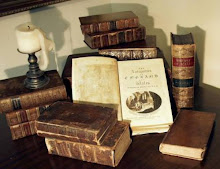Almost all Vermeer has left to explain his style and himself are the paintings. This book goes a long way to logically filling in the gaps in our knowledge of the painter. The tiled floors Vermeer rendered in many of his scenes provided Mr. Steadman with a guide to physically reconstruct eleven paintings. In six of these eleven, when a camera obscura is placed at the point of view, the image produced is the exact same size as the actual painting.
A contemporary of Vermeer noted in his diary that "the most extraordinary and curious aspect" of Vermeer's works was the perspective. It is this mathematically precise perspective that causes our modern eye to find in Vermeer's paintings such a likeness to photography. That many areas of Vermeer's paintings appear to the eye as if out of focus also points to the use of the camera obscura. The reconstructions show remarkably similar effects.
Mr. Steadman tries to discover where Vermeer's room might have been, who might have taught the painter about optics, and the history of the camera obscura. He also addresses the possibilities of other methods for such precise painting, as well as those theories which argue against the use of the camera obscura. The book is full of diagrams, photographic reproductions of some paintings, as well as the paintings themselves. The mathematical results of his research are gathered in charts at the end of the book.
The Music Lesson is unique in that Vermeer revealed his working method, if not himself, in the painting.
 Above the head of the woman is a mirror which shows us the reflection of the painter's stool, easel, and the bottom of the wall to Vermeer's back. The arrangement of stool and easel is just as the artist in The Art of Painting has arranged his. From the appearance of the rear wall, Mr. Steadman is able to figure the precise measurements of the room. From there the approximate measurements of the props are deduced. All of these calculations verify the accuracy of Vermeer's perspective.
Above the head of the woman is a mirror which shows us the reflection of the painter's stool, easel, and the bottom of the wall to Vermeer's back. The arrangement of stool and easel is just as the artist in The Art of Painting has arranged his. From the appearance of the rear wall, Mr. Steadman is able to figure the precise measurements of the room. From there the approximate measurements of the props are deduced. All of these calculations verify the accuracy of Vermeer's perspective.Before someone suggests the use of such an instrument makes Vermeer little more than a painter-by-number, or who merely traces his scenes, x-rays reveal no line drawings or sketches beneath the paint. A camera obscura would be an aid to capturing the precise ratios found in the paintings, but need not dictate the subject or the arrangement of the paintings. There are also many variations, such as several styles of floor tiles in what is apparently the same room, which shows Vermeer did not paint everything precisely as he saw it. In those eleven paintings shines his skill in choosing and arranging a subject, and then rendering it in a special style.
In the end Mr. Steadman reveals what he finds to be that special style: Vermeer was not so much a painter of a scene, like many of his Dutch contemporaries, as he was a painter of light. He exercizes great control over the lighting of his paintings through windows and shutters and curtains. He also has a tendency to leave the outlines of an object undefined, which the mind accounts for. The most obvious example is the nose of the Girl With a Pearl Earring (displayed and further examined with our seventeenth book), which is rendered in the same tone as the cheek, leaving the nose, upon close inspection, without form. Mr. Steadman explains,
Vermeer starts to paint patches of light and colour, not fingers or bodices or violas.There is an excellent website that is a companion to the book, called Vermeer's Camera. There one will find a detailed synopsis of the book, many of the drawings and reconstructions, including some that are not in the book. Mr. Steadman also offers an additional essay similar in style and tone as the rest of the book on The Little Street. Whether or not you believe Mr. Steadman's hypothesis, the book and website provide an astounding wealth of surrounding information and detail concerning Vermeer and his works that anyone interested in the painter or the art would be well advised to read.


Hi,
ReplyDeleteI run the websites AnicentMagicArtTools.com (and a EBay store at http://stores.ebay.com/Camera-Obscura-Lucida-Shop). I sell, among other things, Portable sliding Camera Obscura similar to what Vermeer might have used, and I sell a replica of Cross’ Vermeer’s Camera, which, I’m sure you know, Johannes Vermeer had nothing to do with it, but it is based on a theory about him.
I just wanted to get the word out for people looking to experiment with Vermeer’s techniques. come take a look—it’s very interesting.
Thanks,
Les Cookson
les@thelogfarm.com